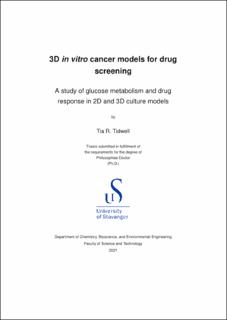| dc.contributor.advisor | Hagland, Hanne | |
| dc.contributor.advisor | Søreide, Kjetil | |
| dc.contributor.author | Tidwell, Tia R. | |
| dc.date.accessioned | 2022-03-15T07:51:56Z | |
| dc.date.available | 2022-03-15T07:51:56Z | |
| dc.date.issued | 2022-03 | |
| dc.identifier.citation | 3D in vitro cancer models for drug screening: A study of glucose metabolism and drug response in 2D and 3D culture models by Tia R. Tidwell, Stavanger : University of Stavanger, 2022 (PhD thesis UiS, no. 630) | en_US |
| dc.identifier.isbn | 978-82-8439-063-5 | |
| dc.identifier.issn | 1890-1387 | |
| dc.identifier.uri | https://hdl.handle.net/11250/2985155 | |
| dc.description.abstract | Current drug screening protocols use in vitro cancer cell panels grown in 2D to evaluate drug response and select the most promising candidates for further in vivo testing. Most drug candidates fail at this stage, not showing the same efficacy in vivo as seen in vitro. An improved first screening that is more translatable to the in vivo tumor situation could aid in reducing both time and cost of cancer drug development. 3D cell cultures are an emerging standard for in vitro cancer cell models, being more representative of in vivo tumour conditions. To overcome the translational challenges with 2D cell cultures, 3D systems better model the more complex cell-to-cell contact and nutrient levels present in a tumour, improving our understanding of cancer complexity. Furthermore, cancer cells exhibit altered metabolism, a phenomenon described a century ago by Otto Warburg, and possibly related to changes in nutrient access. However, there are few reports on how 3D cultures differ metabolically from 2D cultures, especially when grown in physiological glucose conditions. Along with this, metabolic drug targeting is considered an underutilized and poorly understood area of cancer therapy. Therefore, the aim of this work was to investigate the effect of culture conditions on response to metabolic drugs and study the metabolism of 3D spheroid cultures in detail. To achieve this, multiple cancer cell lines were studied in high and low glucose concentrations and in 2D and 3D cultures.
We found that glucose concentration is important at a basic level for growth properties of cell lines with different metabolic phenotypes and it affects sensitivity to metformin. Furthermore, metformin is able to shift metabolic phenotype away from OXPHOS dependency. There are significant differences in glucose metabolism of 3D cultures compared to 2D cultures, both related to glycolysis and oxidative phosphorylation. Spheroids have higher ATP-linked respiration in standard nutrient conditions and higher non-aerobic ATP production in the absence of supplemented glucose. Multi-round treatment of spheroids is able to show more robust response than standard 2D drug screening, including resistance to therapy. Results from 2D cultures both over and underestimate drug response at different concentrations of 5-fluorouracil (5-FU). A higher maximum effect of 5-FU is seen in models with lower OCR/ECAR ratios, an indication of a more glycolytic metabolic phenotype.
In conclusion, both culture method and nutrient conditions are important consideration for in vitro cancer models. There is good reason to not maintain in vitro cultures in artificially high glucose conditions. It can have downstream affects on drug response and likely other important metrics. If possible, assays should also be implemented in 3D. If not in everyday assays, at least as a required increase in complexity to validate 2D results. Finally, metabolism even in the small scope presented here, is complex in terms of phenotypic variation. This shows the importance of metabolic screening in vitro to better understand the effects of these small changes and to model how a specific tumor may behave based on its complex metabolism. | en_US |
| dc.language.iso | eng | en_US |
| dc.publisher | University of Stavanger, Norway | en_US |
| dc.relation.ispartofseries | PhD thesis UiS; | |
| dc.relation.ispartofseries | ;630 | |
| dc.relation.haspart | Paper 1: Alhourani, A., Tidwell, T.R., Bokil, A., Røsland, G.V., Tronstad, K.J., Søreide, K., Hagland, H.R. “Metformin treatment response is dependent on glucose growth conditions and metabolic phenotype in colorectal cancer cells”. In: Scientific Reports. Vol. 11, (2021), DOI: 10.1038/s41598-021-89861-6. | en_US |
| dc.relation.haspart | Paper 2: Tidwell, T.R., Røsland, G.V., Tronstad, K.J., Søreide, K., Hagland, H.R. “Metabolic flux analysis of 3D spheroids reveals significant differences in glucose metabolism from matched 2D cultures of colorectal cancer and pancreatic ductal adenocarcinoma cell lines”. Submitted for publication. Not available in Brage. | en_US |
| dc.relation.haspart | Paper 3: Tidwell, T.R., Røsland, G.V., Tronstad, K.J., Søreide, K., Hagland, H.R. “Enhanced drug screening of CRC and PDAC multicellular spheroids using long-term culture and multi-round exposure to 5-fluorouracil”. Submitted for publication. Not available in Brage. | en_US |
| dc.relation.haspart | Paper 4: Tidwell, T.R., Søreide, K., Hagland, H.R. “Aging, Metabolism, and Cancer Development: from Peto’s Paradox to the Warburg Effect”. In: Aging & Disease. Vol. 8 No. 5 pp. 662–676, (2017), DOI: 10.14336/AD.2017.0713. [Review]. | en_US |
| dc.subject | kjemi | en_US |
| dc.subject | medisinering | en_US |
| dc.subject | kreft | en_US |
| dc.subject | 2D cultures | en_US |
| dc.subject | 3D cultures | en_US |
| dc.title | 3D in vitro cancer models for drug screening: A study of glucose metabolism and drug response in 2D and 3D culture models | en_US |
| dc.type | Doctoral thesis | en_US |
| dc.rights.holder | © 2021 Tia R. Tidwell | en_US |
| dc.subject.nsi | VDP::Matematikk og Naturvitenskap: 400::Kjemi: 440 | en_US |
| dc.subject.nsi | VDP::Medisinske Fag: 700::Klinisk medisinske fag: 750::Onkologi: 762 | en_US |
